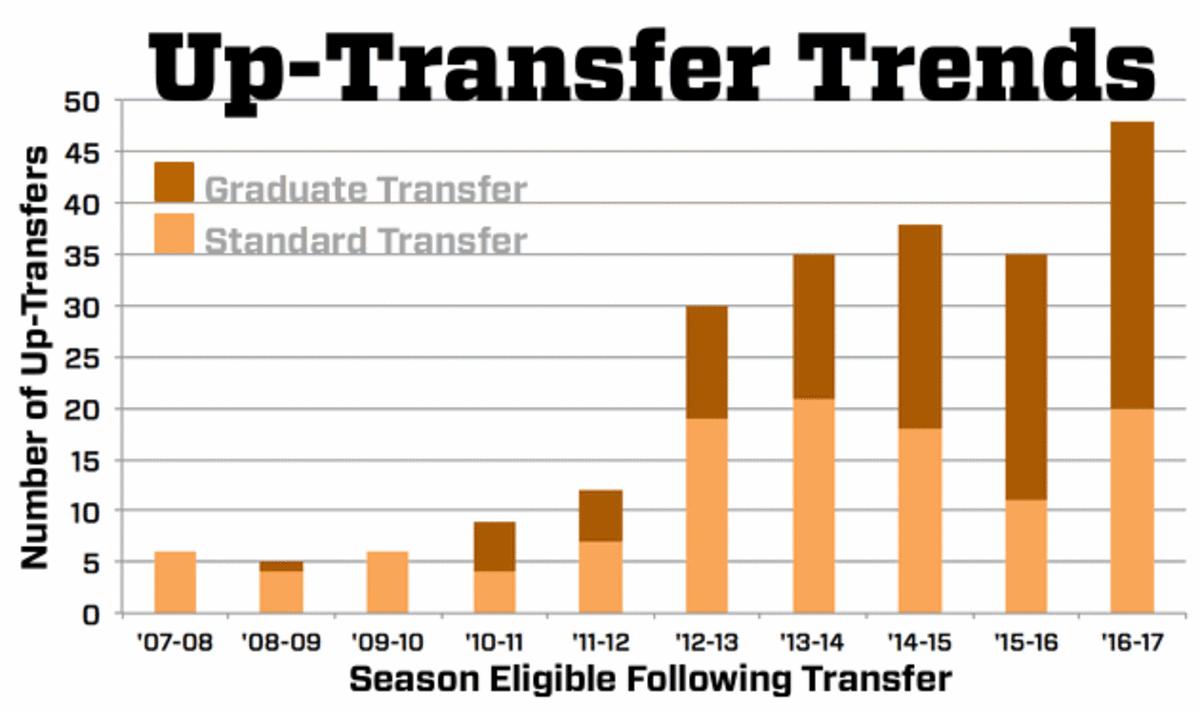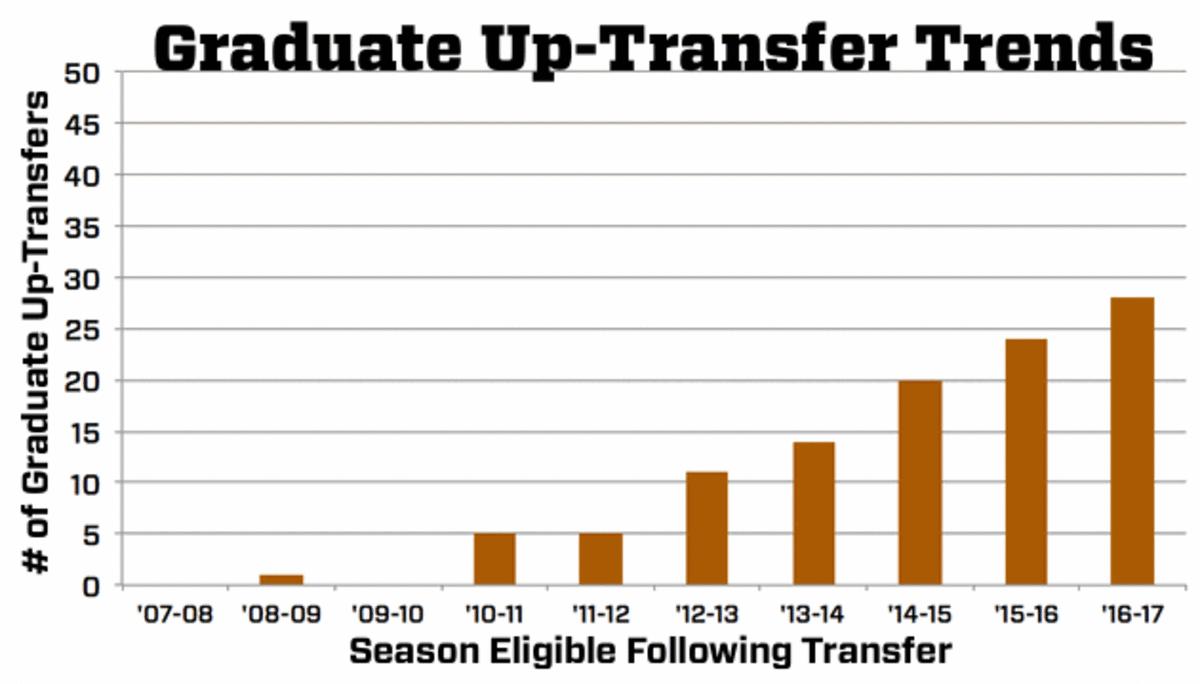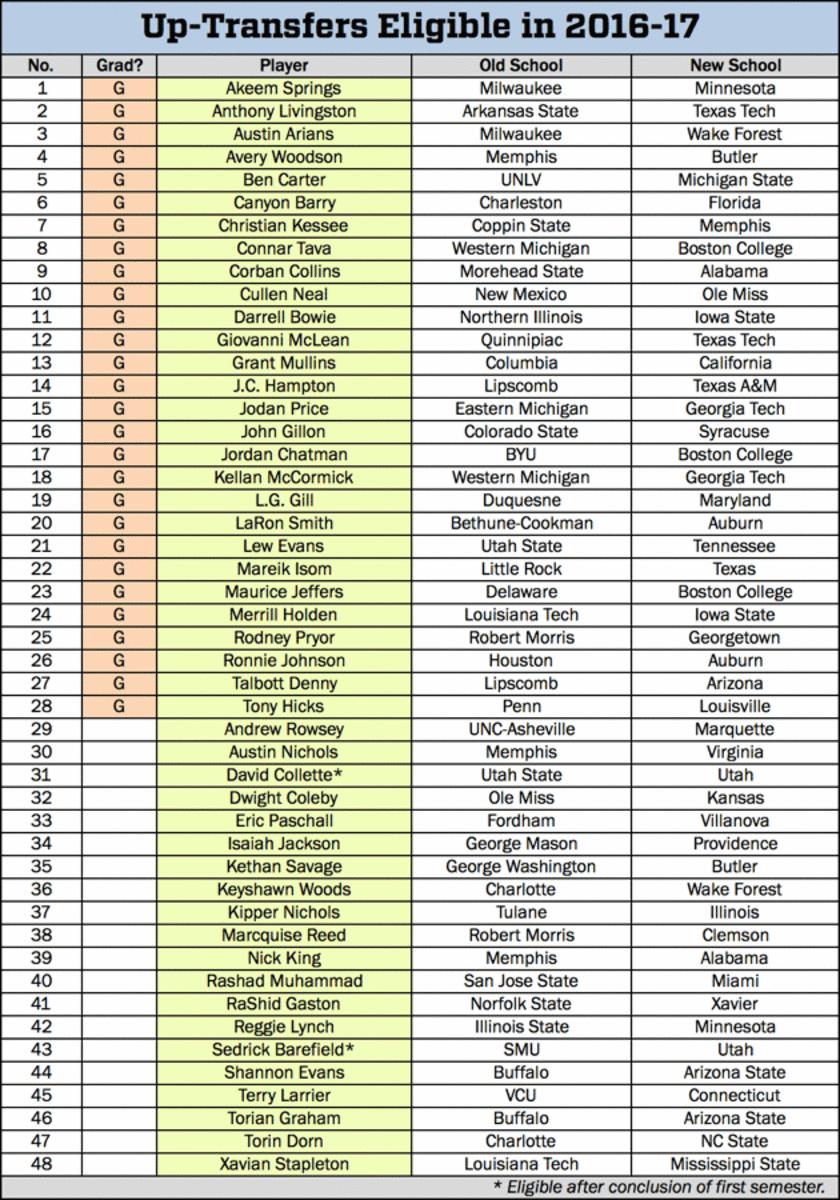Inside the up-transferring boom: Which schools are winning & losing?

Your teams. Your favorite writers. Wherever you want them. Personalize SI with our new App. Install on iOS or Android.
The 2016–17 season, if its preliminary rosters hold, will set a new record for freshly eligible up-transfers. At least 48 are preparing to debut at new schools, the most recognizable being ex-Memphis power forward Austin Nichols, a likely frontcourt star for Virginia, the No. 8 team in my off-season rankings; and ex-Charleston guard Canyon Barry, son of Hall-of-Famer Rick Barry and a possible starter for Florida. As recently as five seasons ago, up-transferring was so rare that the term didn’t exist. From 2007–08 until ‘11–12, an average of 7.6 freshly eligible players fit my definition of an up-transfer—a scholarship player who upgrades his situation by either:
• Transferring from a low- or mid-major to a major (in the ACC, Big East, Big Ten, Big 12, Pac-12 or SEC)
• Transferring from a low- or mid-major to a perennial power outside the big six conferences (Gonzaga, San Diego State, Wichita State, Memphis, or VCU; Xavier and Butler pre-Big East; AAC-era UConn and Cincinnati)
• Transferring from a lesser major-conference team to a program that won a national championship in the past 10 years
The boom began in 2012–13, when 30 up-transfers became eligible, including Luke Hancock, who jumped from George Mason to Louisville, and then was the Most Outstanding Player of the 2013 Final Four. In a column prior to that season, I coined up-transfer to describe a trend that would keep on growing. From ‘12–13 to ‘16–17, the average number of up-transfers becoming eligible is 37.2—a 389% jump from the previous five-year period. In comparison, the overall transfer market has grown by 35–40% between those same five-year periods, according to my estimates based on data from the NCAA and VerbalCommits.com.
Here are the 10-year up-transfer totals in chart form:

My theory on why the up-transfer boom occurred is three-fold. The first part: College basketball’s coaching ranks has far more imitators than it does innovators, and during the nascent stage of up-transferring, some high-profile precedents were set, including Wesley Johnson leaving Iowa State to star for Syracuse’s Sweet 16 team in 2010, Seth Curry leaving Liberty to start on Duke’s Sweet 16 team in 2011, Brandon Wood leaving Valparaiso to start on Michigan State’s Sweet 16 team in ‘12, and the aforementioned Hancock at Louisville.
Next—and this came from the Bylaw Blog’s John Infante—is that from 2009–11, the NCAA curtailed recruiting opportunities at spring AAU events, leaving coaches with more, early off-season time to attempt to improve their roster via the transfer market. Most transfers recruited during the 2011 offseason became eligible in ‘12–13, which was the year the boom started.
Finally (and most obviously), the graduate-transfer exception is helping fuel the boom, by offering an instantly eligible option for certain seniors to upgrade schools. The exemption permits a player who’s earned an undergraduate degree, still has eligibility remaining, and wants to pursue a graduate degree not offered at his current school to transfer somewhere that offers that degree and play right away. The first known graduate up-transfer was Bassirou Dieng, who went from St. Francis (Pa.) to Georgia Tech in 2008–09. This off-season, 58.3% of the overall up-transfers (28) are graduates, including Barry and Grant Mullins, who left Columbia and is likely to be Cal’s starting point guard.
Here are the 10-year totals for graduate up-transfers only, in chart form:

Up-transferring has become so prevalent that half of the 32 teams in SI’s off-season Power Rankings have up-transfers on their 2016–17 rosters, including No. 1 Duke (ex-Rice forward Sean Obi), No. 2 Kansas (ex-Ole Miss forward Dwight Coleby), and No. 3 Villanova (ex-Fordham forward Eric Paschall). The programs that should be considered Up-Transfer U, however, are unlikely to crack any national rankings this season.
Illinois and Boston College have each brought in a nation-high eight up-transfers since 2007–08. The Illini’s haul only yielded one hit, Rayvonte Rice, who left Drake in 2012; the rest were Sam Maniscalco (who graduated from Bradley in 2011), Sam McLaurin (graduated from Coastal Carolina in 2012), Jon Ekey (graduated from Illinois State in 2013), Darius Paul (left Western Michigan in 2013), Khalid Lewis (graduated from La Salle in 2015), Mike Thorne Jr. (graduated from Charlotte in 2015) and Kipper Nichols (left Tulane in 2015 before ever appearing in a game). BC’s first up-transfer in the study, ex-Vermont forward Joe Trapani, had major value for the Eagles from 2008-11, but they’ve struck out on impact players since.
Rank | school | # of up-transfers |
|---|---|---|
1t | Illinois | 8 |
1t | Boston College | 8 |
3t | Florida | 7 |
3t | Iowa State | 7 |
3t | USC | 7 |
3t | Georgia Tech | 7 |
7t | Oregon | 6 |
7t | Seton Hall | 6 |
7t | Connecticut | 6 |
The schools that have reaped the biggest benefits from the up-transfer market are Iowa State, which added key pieces of eventual elite teams when it brought in DeAndre Kane from Marshall (who became eligible in ‘13–14), Abdel Nader from Northern Illinois (‘14–15) and Bryce DeJean-Jones from UNLV (‘14–15), and Oregon, which had a run of up-transfers that were high-impact starters. The Ducks started with Olu Ashaolu from Louisiana Tech (eligible in ‘11–12), then had Arsalan Kazemi from Rice (‘12–13), and Jason Calliste from Detroit, Joseph Young from Houston and Mike Moser from UNLV (all in ‘13–14).
Rank | School | # Up-transfers lost |
|---|---|---|
1 | Houston | 6 |
2t | Charlotte | 5 |
2t | Memphis | 5 |
4t | Illinois State | 4 |
4t | San Francisco | 4 |
4t | Cleveland State | 4 |
4t | Cornell | 4 |
4t | Rice | 4 |
4t | UNLV | 4 |
4t | South Florida | 4 |
4t | Western Michigan | 4 |
The program that’s been hit the hardest by departing up-transfers is Houston, which has lost a nation-high six since 2007–08, including players that went on to be high-quality starters at Oregon (Young), Texas A&M (Danuel House) and Oklahoma (TaShawn Thomas). Cleveland State, meanwhile, had a potential Horizon League championship team dissolve when it lost up-transfers to Michigan State (Bryn Forbes), Louisville (Trey Lewis) and Wichita State (Anton Grady). But those players did succeed in upgrading their situations, as Forbes was a key member of two NCAA tourney teams at Michigan State and is playing NBA Summer League with the Spurs; Lewis got more exposure while starting for a ranked Louisville team; and Grady finally made a trip to the NCAA tournament as a frontcourt starter for Wichita State.
It looks as if a few of 2016–17’s eligible up-transfers could be in for similar—and justifiable—upgrades. Nichols left Memphis a year before his coach, Josh Pastner, bolted for Georgia Tech, and now Nichols is a projected starter for a top-10 preseason team at Virginia. Anthony Livingston grad-transferred out of Arkansas State after his coach, John Brady, resigned. One of the nation’s better, small-conference rebounders, Livingston now gets a chance to prove he can grab boards in the Big 12 at Texas Tech. And Grant Mullins, a grad transfer who’ll be trying to reach his first NCAA tournament at Cal, left Columbia after his coach, Kyle Smith, did something that’s forever been tradition for promising, small-conference coaches: He upgraded jobs, leaving the Ivy League for the University of San Francisco.
Complete List of Up-Transfers Eligible in 2016–17

